Canon SX720 HS review
-
-
Written by Ken McMahon
In depth
Canon’s PowerShot SX720 HS is the company’s flagship pocket super-zoom camera. Announced in February 2015 it’s the successor to the year-old SX710 HS. The SX720 HS shares the same 20 Megapixel resolution and 1080 / 60p movie mode as its predecessor, but extends the optical zoom range from 30x to 40x while maintaining virtually the same body size.
The new zoom features a range equivalent to 24-960mm, allowing it to out-gun the 30x / 24-720mm of its arch rival, the Lumix TZ80 / ZS60. Canon’s secret in accommodating the long range in the small body is greater use of UHD (ultra-high dispersion) glass elements. However, unlike the Lumix which manages to squeeze-in an electronic viewfinder, the Canon entirely relies on its screen for composition. And the screen on the Lumix is touch-sensitive, whereas the Canon is not. As before the best-quality movie mode is 1080 / 60p, although again Panasonic has taken the higher ground by equipping the TZ80 / ZS60 with 4k capabilities and the chance to extract 8 Megapixel stills from footage.
Overall while the Lumix TZ80 / ZS60 has arguably the better overall specification, many buyers in this market are simply after the longest zoom in the smallest and most affordable body and the SX720 HS certainly zooms longer and comes in cheaper than the Panasonic. Is it really all about the zoom, or is the Lumix a better all-round travel zoom that’s worth the extra? Read my full review to find out.
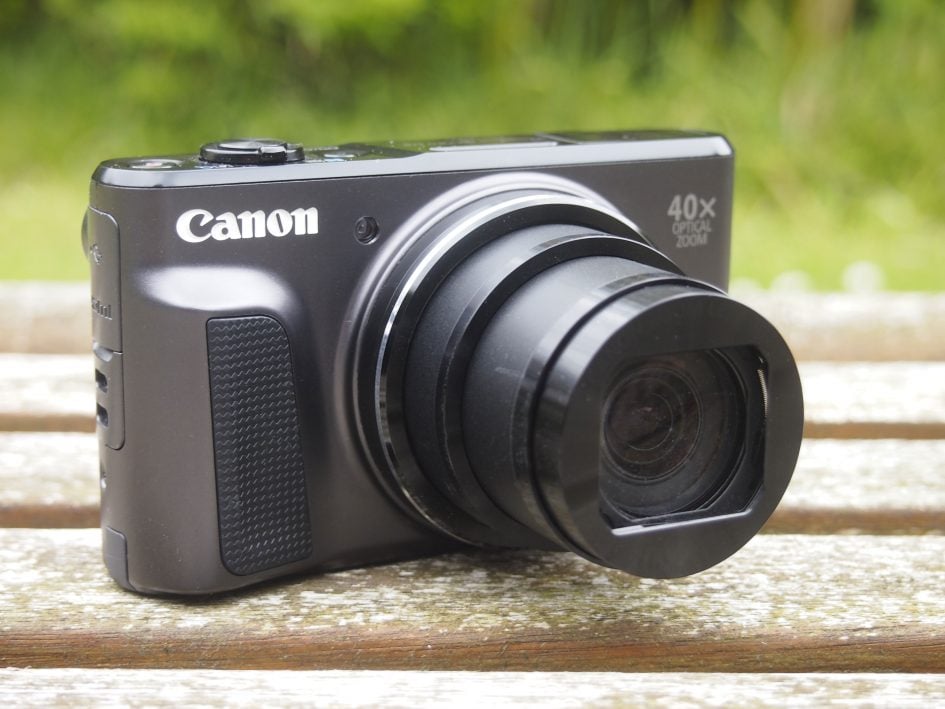
Canon PowerShot SX720 HS design and controls
The PowerShot SX720 HS is a little boxier than its predecessor; the sloping top panel is now flat, the curves have been straightened and the corners squared. Impressively, Canon has managed to maintain the same weight and slightly reduce the dimensions of the new model which at 110x64x36mm and 270g is also marginally smaller and lighter than the Panasonic Lumix TZ80 / ZS60.
So full marks to Canon for squeezing a 40x zoom into a smaller body than the earlier 30x model, but don’t forget the Lumix TZ80 / ZS60 boasts an electronic viewfinder and a touch screen, so it too deserves credit for its compactness.
With a such a massive zoom range in such a compact body, comfort is all important – at longer zoom ranges you need to be able to hold the PowerShot SX720 HS nice and steady. Improvements to the grip surfaces help here – there’s a simplified grippier soft strip on the front of the camera and a new thumb pad to the left of the mode dial on the rear. The thumb pad could be bigger – it’s a bit of a squeeze to fit your thumb between the mode dial and the screen, but it’s better that nothing.
Though the body shape has changed, the control layout remains broadly similar. The on/off and movie record buttons on the top panel are now recessed, making them less prone to accidental activation. On the rear panel the buttons are all in the same place, though some have been relabelled and function slightly differently. The display button is now called Info, but toggles display overlays as before. The dedicated button for connecting to your phone via Wifi now has a Wifi antenna icon instead of a phone and can be used to connect to other devices as well as a smartphone. And the top position of the rear dial now offers album and event playback options.
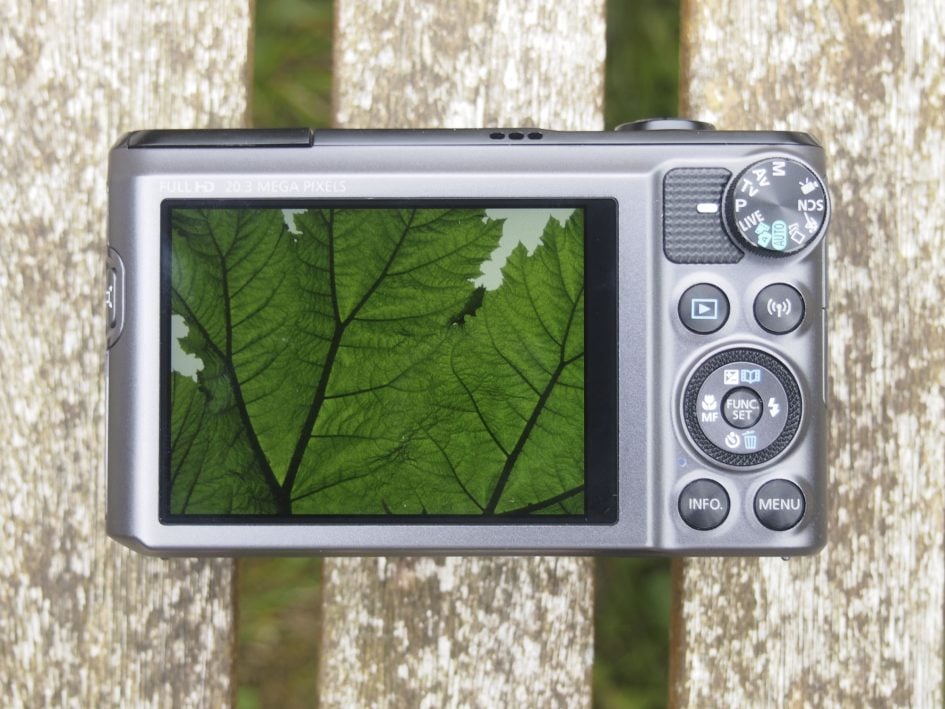
The USB port and mini HDMI connector are located behind a plastic flap on the left side of the body. The Canon battery is charged using an external AC charger, supplied with the camera; sadly unlike the Panasonic and Sony, there’s no in-camera charging over USB, a feature I find particularly useful on a camera designed for travel.
The SX720 HS is powered by the NB-13L Lithium Ion pack which Canon estimates is good for 250 shots, fewer than its rivals, but if you’re prepared to put up with the screen darkening after a couple of seconds and switching off after ten seconds, then the camera switching off altogether after three minutes of activity, the ECO mode will stretch a fully charged battery to a very respectable 355 shots.
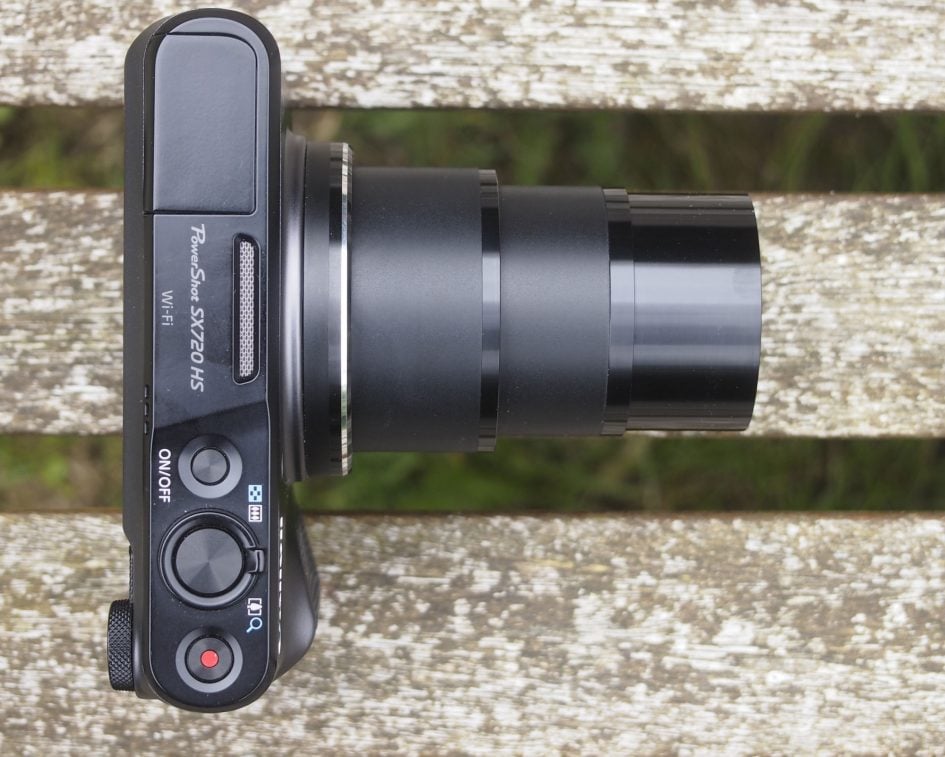
Before we move on to talk about the lens there’s one other button on the PowerShot SX720 HS that you need to know about and that’s the Framing Assist Seek button. Holding this button down temporarily zooms out so you can get your bearings before releasing the button and zooming back to exactly where you were; it’s particularly useful for keeping track of moving subjects. It also has some other clever features that I’ll talk about in the Shooting Experience section below.
Canon PowerShot SX720 HS lens and stabilisation
The headline feature of the PowerShot SX720 HS is of course its 40x optical zoom. With an equivalent range of 24-960mm it starts at the same super-wide angle focal length as the Lumix TX80 / ZS60, but extends 25 percent further at the telephoto end of the range with a maximum equivalent zoom of 960mm compared with 720mm on the Lumix. Below you can see the extent of the PowerShot SX720 HS’s range.
Canon PowerShot SX720 HS coverage, wide & tele

Above: Canon PowerShot SX720 HS at 4.3mm (24mm equivalent) and at 172mm (960mm equivalent)

Above left: Canon PowerShot SX720 HS at 172mm (960mm equivalent). Above right: Lumix TZ80 / ZS60 at 129mm (720mm equivalent)
Both the PowerShot SX720 HS and Lumix TZ80 / ZS80 have a maximum aperture at the wide angle setting of f3.3, not particularly bright, but the norm for super-zoom lenses. The Canon closes to f6.9 when fully zoomed compared with f6.4 for the Lumix, but if you zoom the SX720 HS to the 720mm maximum of the TZ80 / ZS60 it closes to the same f6.4.
What does this mean in practice? Well, for low light shooting there’s not much to choose between the Lumix TZ80 / ZS60 and the PowerShot SX720 HS. In similar situations, for example shooting in low light while zoomed in, you’ll face similar problems – selecting a sufficiently fast shutter speed to avoid camera shake while at the same time trying to avoid raising the sensitivity so high that it compromises quality.
You’ll also get similar results if you’re trying to throw backgrounds out of focus by selecting a large aperture to reduce the depth of field. Here the PowerShot SX720 HS has a slight advantage in two respects; it can zoom in further, producing a slightly blurrier background, and it can get a little closer for macro shots. But for portraits at middling focal lengths, there’s really not much difference between the two. Below I’ve included a pet portrait example shot with both cameras at approximately the same focal length at the widest available aperture, which is pretty much equivalent on both cameras throughout the zoom range. As you can see, neither the Powershot SX720 HS nor the Lumix TZ80 / ZS60 are capable of blurring the background very much.

Above: Canon PowerShot SX720 HS Aperture Priority 1/100 f5 80 ISO 16.54mm (92mm equivalent)

Above: Panasonic Lumix TZ80 / ZS60 Aperture priority 1/80, f4.9, 80 ISO, 16.1mm (89mm equivalent)
At longer focal lengths depth of field becomes shallower, so there’s more opportunity to throw the background out of focus. In the next example the Lumix TZ80 / ZS60 is first. I zoomed it to its maximum 720mm equivalent focal length and set the maximum f6.4 aperture in Aperture Priority mode. I then attempted to match the focal length and aperture on the PowerShot SX720 HS and shot the same scene. In the absence of a focal length readout on the SX720 HS (The Lumix has one) I attempted to match the framing and, as it turns out, I was a little bit short of the mark, nonetheless I think these examples show that at longer focal lengths, though you can blur the background more, there’s not much to chose between the Lumix TZ80 / ZS60 and the PowerShot SX720 HS.
That’s not the end of the story though, The PowerShot SX720 HS can of course zoom in further than the Lumix TZ80 / ZS60, to a maximum 960mm equivalent. The third example below shows how that looks. Despite the lens closing to f6.9 at this focal length, you can get a blurrier background than on either model at 720mm equivalent.
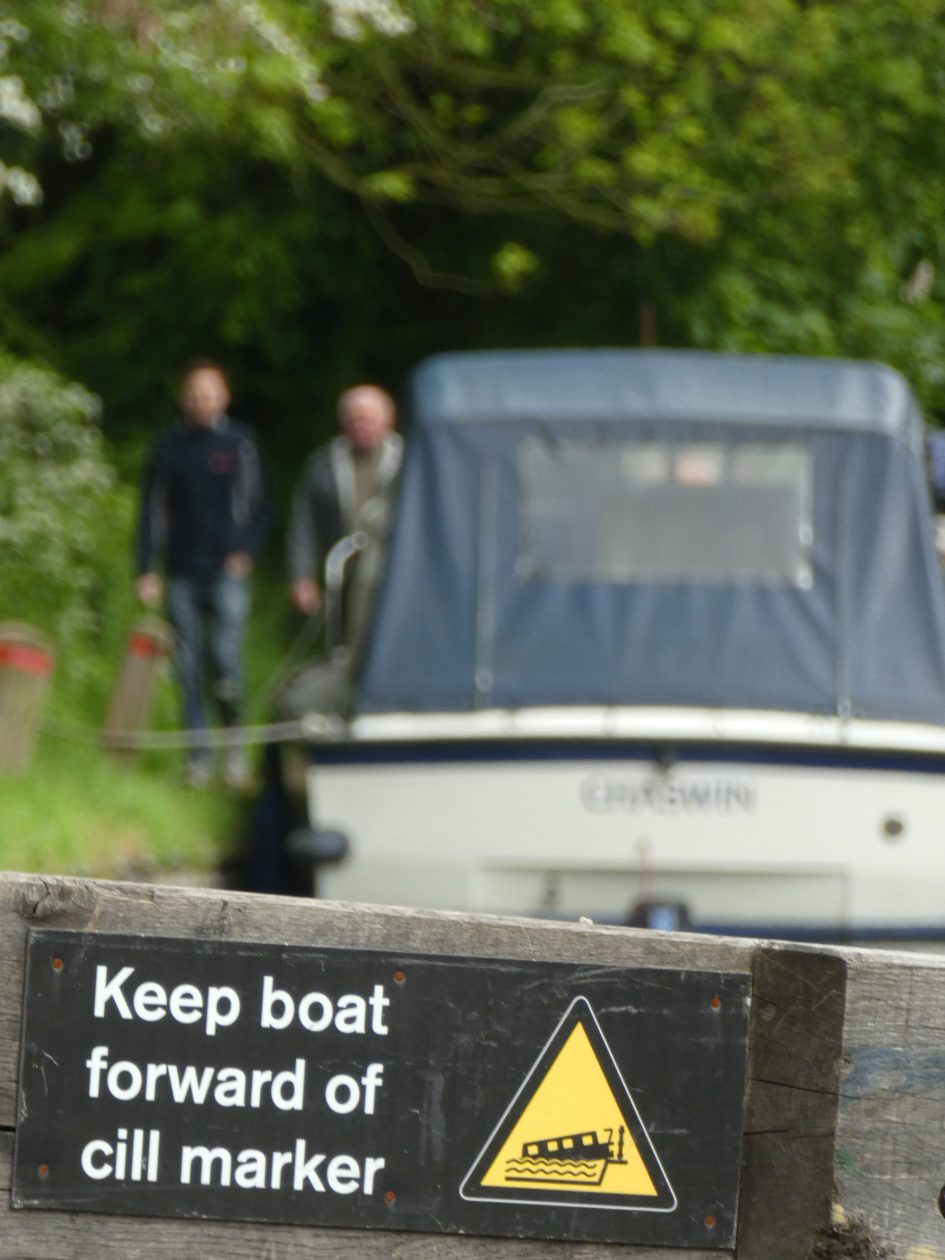
Above: Panasonic Lumix TZ80 / ZS60 Aperture priority 1/160, f6.4, 200 ISO, 129mm (720mm equivalent)

Above: Canon PowerShot SX720 HS Aperture Priority 1/125 f6.3 200 ISO 110mm (613mm equivalent)

Above: Canon PowerShot SX720 HS Aperture Priority 1/125 f6.9 200 ISO 172mm (960mm equivalent)
The SX720 HS is equipped with image stabilisation which shifts the lens elements to compensate for camera movement. To test it I took a sequence of shots at progressively slower shutter speeds with the lens zoomed to its maximum 960mm focal length. As you can see from the crops below, the SX720 HS can take sharp hand-held shots at speeds down to 1/25, that’s a very impressive five stops of stabilisation over what I needed to handhold the same result without stabilisation.
Canon PowerShot SX720 HS Image Stabiliser off / on
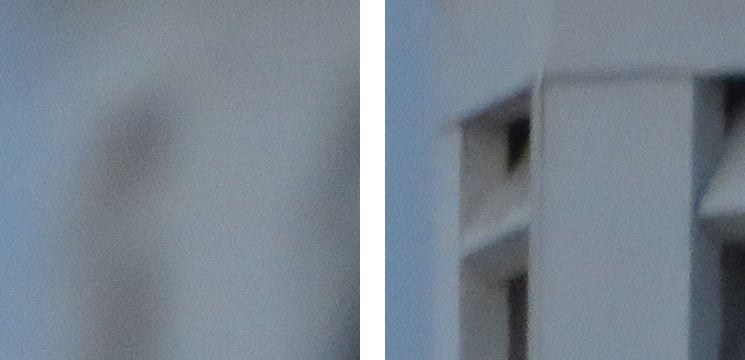
Above left: 100% crop, 4.3-172mm at 172mm, 1/25, 400 ISO, IS off. Above right: 100% crop, 4.3-172mm at 172mm, 1/25, 400 ISO, IS on
Canon PowerShot SX720 HS movie modes
The Canon PowerShot SX720 HS retains the same movie options as the earlier SX710 HS. It can record Full HD movies with stereo sound and control over the optical zoom while you’re filming. The best quality mode is 1080/60p with 1080/30p 720/30p and VGA also at 30fps. There’s a dedicated movie mode on the dial, but you can actually start recording video from any mode by simply pressing the red record button on the back. This may sound like it renders the movie mode position on the dial redundant, but selecting it puts the screen into 16:9 mode for more accurate framing, unlocks the 60p option, and also allows selection of Short Clip and iFrame modes from the Func. Set menu. Canon recommends using an SD memory card rated at Class 6 or quicker for movies. The maximum recording time is when the file reaches a second shy of half an hour or 4GB in size, or of course if the battery runs out first.
Note that slow motion options available on earlier models were dropped on the earlier SX710 HS, presumably due to a limitation of the higher resolution sensor; if you want slow motion on a 2016 30x super-zoom, the Lumix TZ80 / ZS60 will give them to you.
Moving on, once you start filming the exposure control is fully automatic, although if preferred, you can lock the exposure or adjust it in a +/-2EV range prior to filming. Some of the Creative Effects can also be applied to movies, although others are ignored. Press the movie record button while Fisheye, Toy Camera or Soft Focus are selected and the camera will just ignore them and film as normal, but it will apply the Monochrome, Super Vivid, Poster or Miniature effects to video.
In a bizarre approach inherited from earlier Canon compacts though the Miniature mode ignores whatever movie quality you’ve previously selected and uses the still photo shape to dictate the video format. With the photos set to the default 4:3 shape for the best photo quality, Miniature movies will only be recorded in VGA resolution. If you want widescreen HD Miniature movies, you’ll first need to set the photo shape to 16:9, and even then the Miniature mode will only record video at 720p, not 1080p. This remains a very odd way of doing things, when Canon should simply apply the desired movie format to any mode, or offer Miniature effects direct from the dedicated movie mode.
A Dynamic IS mode improves stabilization although with a slight crop of the field of view. If you’d like to capture the same field of view as stills, you should change the IS mode in the menu and accept slightly reduced stabilization performance. I used the default Dynamic IS mode 1 which applies a crop for my hand-held sample videos below and as you’ll see it proved very effective even when panning handheld with the camera zoomed all the way in.
Here’s a selection of clips to demonstrate the SX720 HS’s video performance in various conditions.
Download the original file (Registered members of Vimeo only)
Above: For this hand-held panning shot, and the others below I set the mode dial to the movie position enabling the best quality 1080 / 60p mode. Stabilisation was enabled and, as you’d expect, it does a great job when zoomed out. Any stabilisation system is going to struggle at 960mm but the SX720 HS actually does a pretty good job, but if you’re planning to zoom to the full extent like this it’s probably a good idea to find a wall to lean against, or some other way to steady the camera.
Download the original file (Registered members of Vimeo only)
Above: For this panning shot I mounted the SX720 HS on a tripod and disabled the stablisation. The SX720 HS has a two-speed zoom and for this and the previous clip I used the slower of the two speeds which is pretty much inaudible. The quality is quite nice, but of course the Canon can’t match the 4k mode available on the Lumix TZ80 / ZS60.
Download the original file (Registered members of Vimeo only)
Above: This low light interior scene looks a little on the noisy side, but the SX720 HS copes well with the changing light, particularly the windows at the beginning.
Download the original file (Registered members of Vimeo only)
For this final clip I zoomed the SX720 HS in a little and panned from the glass of beer in the foreground up to the bar and back again. The SX720 HS responds pretty quickly going from glass to bar, but its very slow in the other direction. With its depth by defocus technology, the Lumix TZ80 / ZS60 is more responsive, plus its touch screen allows you to tap to focus.
Canon PowerShot SX720 HS shooting experience The PowerShot SX720 HS is comfortable to hold and, at wider focal lengths, framing and shooting is something you really don’t have to think about too much. The challenges, as with any compact super-zoom, come when you zoom into longer focal lengths. Then it becomes more difficult to keep the camera steady to avoid camera shake, but also to keep your subject in the frame, especially if it’s alive and moving about. With only the screen to compose your images and with a longer zoom than the viewfinder equipped Lumix TZ80 / ZS60, this is something you really need to think about if you’re hoping to get, say, great wildlife or sports shots.
Holding down the Framing assist seek button temporarily zooms out so you can get your bearings before releasing the button and zooming back to exactly where you were; it’s particularly useful for keeping track of moving subjects.
A short press on the button activates Seek assist auto mode; if you lose track of a subject while zoomed in and move the camera to re-acquire it, the SX720 HS automatically zooms out to help you locate it. Once you find your subject and stop moving, the camera zooms back in. You can also use Seek Assist Auto to keep moving faces the same size in the frame, the SX720 HS zooms in or out (in steps, not smoothly) as your subject moves towards or away from the camera.
These features are invaluable when you’re shooting moving subjects when zoomed in and without them framing at the full extent of the SX720 HS’s zoom is a pretty challenging task. But they’re no substitute for an electronic viewfinder. When shooting fast moving sports, for example, I found it a lot easier to keep the subject in the frame using the Lumix TZ80 / ZS60’s viewfinder.
The PowerShot SX720 HS has a fastest continuous shooting speed of 5.9fps with the focus locked on the first frame which slows a little to 4.6fps with continuous AF. I tested it with a fast freshly formatted SD card and it fired a burst which I timed at a little faster than 6fps. Had I held the shutter down I’m fairly sure it would have continued at that speed until the card was full.

So the PowerShot SX720 HS matches the quoted continuous shooting speed, and for short bursts of relatively close subjects, like kids playing, or pets, it’s great. But for faster moving action further away composing with the screen and the lag between the display and reality (the SX720 HS displays the previous frame, and sometimes the lag is longer) makes keeping the subject in the frame as much down to luck as judgement.
Assuming you can successfully frame your subject the PowerShot SX720 HS does a good job of quickly acquiring focus when you half-press the Shutter release. In good light and with the right subject it’s near-instantaneous at wide angle zoom settings. In failing light and when fully zoomed in, however, the SX720 HS let me down on numerous occasions. I’m not talking about trying to shoot street life at night, even shooting stationary subjects like buildings in the ‘blue hour’ after the sun had set, but it was still light, the SX720 HS sometimes took several seconds of back and forth hunting before it was able to acquire focus and on some occasions it failed altogether.
Another issue I have with the AF system on the SX720 HS as well as many other Canon compacts is the inability to reposition the single AF area manually. If you choose single area, then it’s permanently locked to the middle of the frame. If you’d like the camera to focus elsewhere on the frame, you’ll have to switch it to Face / AiAF mode and hope it recognises the desired subject. To be fair the SX720 HS does a good job at subject recognition in the auto modes, but there are times when I like to reposition the AF area manually and sadly it’s not possible here.

At this point it’s worth noting the difference in sophistication between the SX720 HS and the Lumix TZ80 / ZS50. While the Lumix is happy to do everything for you if you want, it unlocks far more control for those who want greater involvement, whereas the Canon is much more aimed at those who literally wish to point-and-shoot. The presence of a built-in viewfinder, customisable buttons, touchscreen, twin control dials and support for RAW files all set the Lumix apart.
So if you want the greatest control in this form factor, then the Lumix is for you. But the Canon fights back with simplicity and a lower price tag in some regions and of course the longer 40x zoom. It’s enormously liberating to spot a distant subject and know it’s within reach even with a camera that fits in your pocket and the SX720 HS’s maximum 960mm equivalent zoom means there’s almost no subject too distant to capture.
Canon PowerShot SX720 HS Wifi
Moving on, the SX720 HS is equipped with Wifi which lets you wirelessly remote control the camera, transfer images or tag them with GPS positions logged by your phone. You’ll first need to install the free Camera Connect app then register your phone with the camera; you can then select the phone via the Wifi menus, or simply by pressing the dedicated Wifi button on the camera. Like most Wifi implementations, the camera sets itself up as an access point which you then connect to with the phone. The presence of NFC eases the process on compatible Android phones, but the entire process isn’t as slick as Sony’s where a single touch between camera and phone will fire-up both device’s Wifi, connect them, transfer an image or remote control, before then disconnecting and turning Wifi off again, all automatically. As it stands you’ll need to turn Wifi on yourself on the Canon, and depending on your luck with NFC, you may need to initiate the connection too. This is similar to how the Lumix worked in my tests too – only Sony has managed to make the process seamless.
Once you’re connected, the smartphone app presents four options: Images on Camera, Remote Shooting and Location Information. The first option presents a series of thumbnails which you can examine before copying over if desired. The remote control option presents a live view of the scene with the chance to zoom the lens, adjust the exposure manually if desired, along with choosing various AF and drive options. It’s great to find manual exposure control here – introduced on the earlier SX710 HS – but sadly there was no chance to tap to reposition the AF area using your smartphone. In contrast, the Lumix Image App not only lets you tap to reposition the AF area using your handset, but also lets you do it while filming a video to pull-focus without ever touching the actual camera.
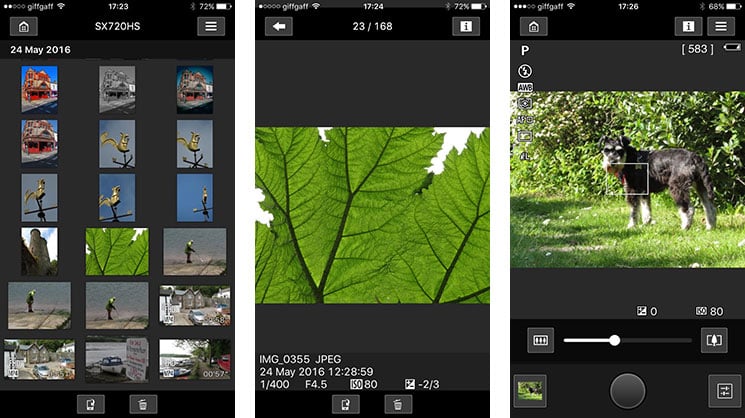
The third option lets you record a location log with your handset before syncing the co-ordinates later. Having to log then tag images with positions isn’t as easy as simply having a GPS receiver built-into the camera to start with, but it does at least work and judging from current rivals, few if any have GPS hardware anymore.
Finally the fourth option allows you to remotely copy the date and time settings from your phone to the camera. At first I thought ‘why would anyone one want to do that remotely’, but it’s a lot less of a faff that having to navigate through the camera menu to set the date and time, and particularly useful if you find yourself travelling to different timezones.
The PowerShot SX720 HS inherits the same shooting modes as its predecessor, including of course the traditional PASM modes, (or P, Tv, Av and M as they’re denoted on all Canon cameras) and Smart Auto with scene detection.
The Live position on the mode dial provides a simple interface for novices to experiment with exposure compensation, saturation and white balance via three sliders labelled Dark/Light, Neutral/Vivid and Cool/Warm. It’s a small step from here to switch to Program mode and use the exposure compensation button, or press the Func. button and alter the white balance setting from the Func. menu. Canon’s Hints and Tips feature provides some explanation of these more advanced settings.
The Creative filters on the SX720 HS are selected from the Scene mode menu and include Fish-eye, Miniature, Toy camera, Soft Focus, Monochrome, Super-vivid and Poster Effect; most offer several variants. The Miniature mode is one of the most versatile ’tilt shift’ effect filters around and allows you to flexibly position the focus zone in the frame in either landscape or portrait orientation.
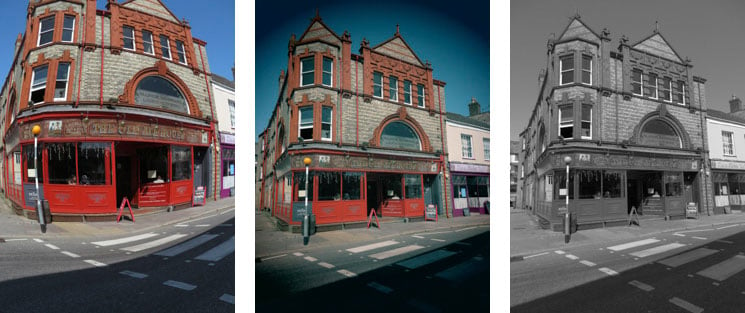
Along with the Monochrome, Super-vivid and Poster Creative filters it can also be used for movie shooting. However you need to take care with this; as noted above, the Miniature mode ignores whatever movie quality you’ve previously selected and uses the still photo shape to dictate the video format. With the photos set to the default 4:3 shape for the best photo quality, Miniature movies will only be recorded in VGA resolution. If you want widescreen HD Miniature movies, you’ll first need to set the photo shape to 16:9, and even then the Miniature mode will only record video at 720p, not 1080p. This remains a very odd way of doing things, when Canon should simply apply the desired movie format to any mode, or offer Miniature effects direct from the dedicated movie mode.
Creative Shot mode is an extension of the filter effects which automatically applies a selection of them to a shot to produce six variations. The SX720 HS uses scene detection to determine which effects to apply and it also crops some images to produce new compositions. All six versions are then displayed for a couple of seconds and if you press the Func Set button you can review them individually though, of course, you can play them back at any time just like other shots. The SX720 HS also includes the Smart shutter modes which automatically fire the shutter when a smile is detected or start the self time when you wink or when a new face enters the frame.
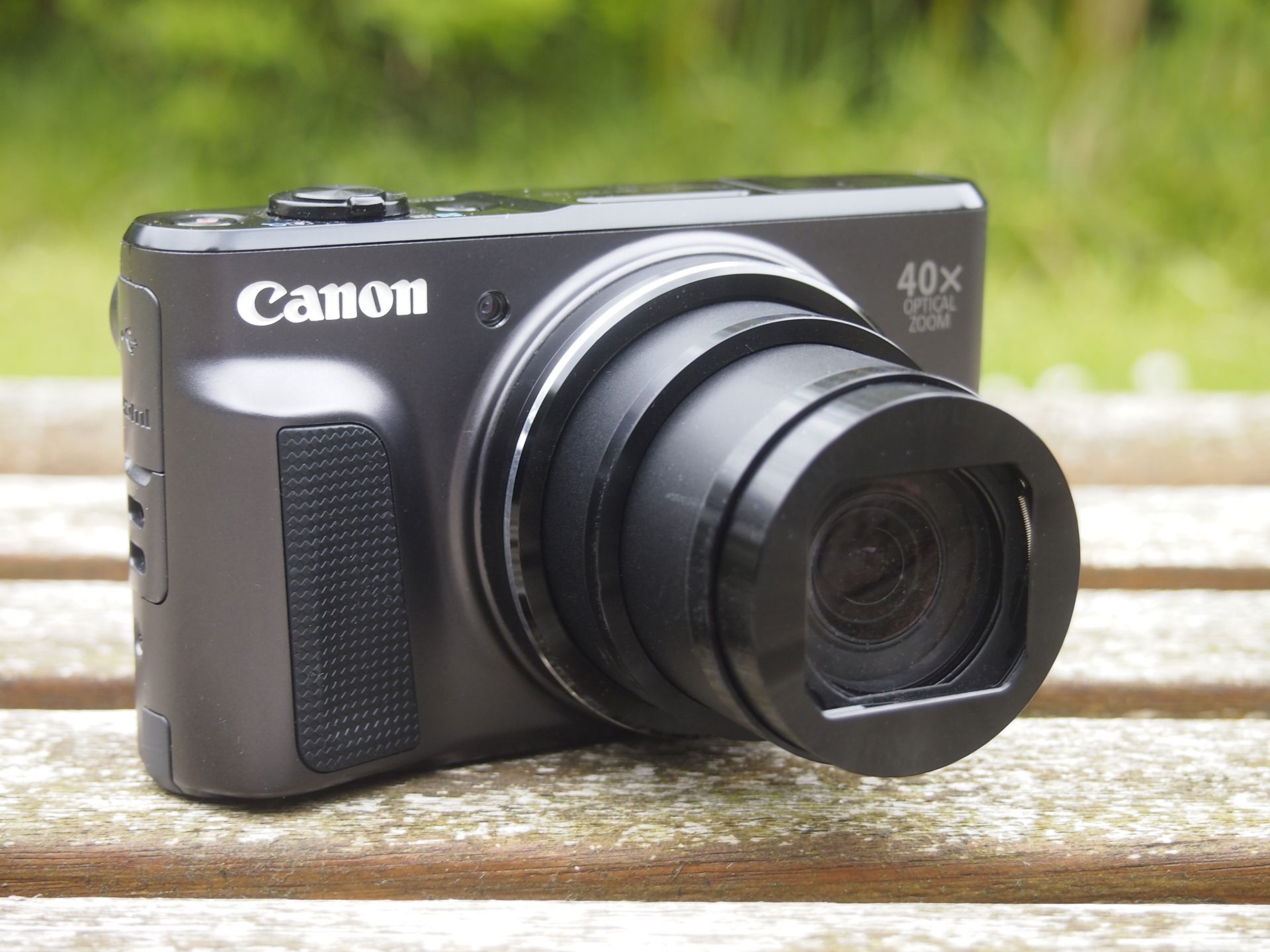
 Canon's PowerShot SX720 HS is the company's flagship pocket super-zoom camera, boasting nothing less than a 40x optical zoom. It shares the same 20 Megapixel resolution and 1080 / 60p movie mode as its predecessor, the SX710 HS, but extends the optical zoom range from 30x to 40x while maintaining virtually the same body size. The new zoom features a range equivalent to 24-960mm, allowing it to out-gun the 30x / 24-720mm of its arch rival, the Lumix TZ80 / ZS60. In terms of other features, the SX720 HS falls behind the Lumix, lacking a viewfinder, touch-screen, 4k video and RAW recording, but Canon has focused on delivering the longest zoom in the smallest body and in those terms the SX720 HS doesn't disappoint. If it's a long zoom you're looking for, there's nothing to touch it in this form-factor, but if you're happy with a 30x range and can spend a little extra, the Lumix TZ80 / ZS60 comfortably out-features it in every other department.
Canon's PowerShot SX720 HS is the company's flagship pocket super-zoom camera, boasting nothing less than a 40x optical zoom. It shares the same 20 Megapixel resolution and 1080 / 60p movie mode as its predecessor, the SX710 HS, but extends the optical zoom range from 30x to 40x while maintaining virtually the same body size. The new zoom features a range equivalent to 24-960mm, allowing it to out-gun the 30x / 24-720mm of its arch rival, the Lumix TZ80 / ZS60. In terms of other features, the SX720 HS falls behind the Lumix, lacking a viewfinder, touch-screen, 4k video and RAW recording, but Canon has focused on delivering the longest zoom in the smallest body and in those terms the SX720 HS doesn't disappoint. If it's a long zoom you're looking for, there's nothing to touch it in this form-factor, but if you're happy with a 30x range and can spend a little extra, the Lumix TZ80 / ZS60 comfortably out-features it in every other department.



